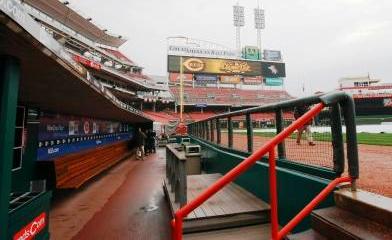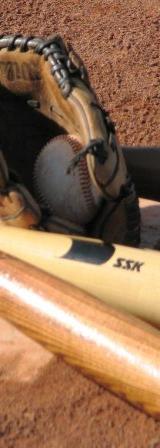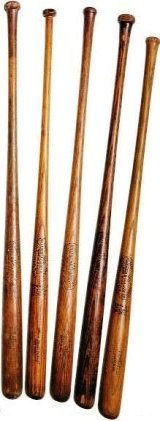|
~ Baseball Rules: Tagging Up. When Do I Need To Tag, And When Can I Run? ~
As written in the baseball rules, tagging up before a runner can attempt to advance to the next base on a fly ball/pop fly/ or line drive, with less than two outs is required.
The runner must return to the occupied base, stay in contact with that base, until the fielder has caught, or dropped the ball. The base runner may then attempt to reach the next base.
The penalty for running before the ball is caught, if discovered, the runner will be called out.
For beginning players, the most difficult part is to get them to wait until the ball has been caught by the fielder. They often go back to the base, touch it, then turn and run towards the next base while the ball is still in the air.
For the more experienced, the most difficult part is timing their departure with the catch, controlling the emotions that are generated by the upcoming play, which can be one of the most exciting in baseball.
It is one of those "too much time to think scenarios."
Rules Tips ~ From the Dugout

If you are a runner on 3B, tag up immediately on all fair and foul balls in the air, with less than two outs.
Often, younger players do not realize that they can tag and run on a caught foul, fly ball. Probably best not to assume that all players, young or old know this, and make a point to mention it.
Players should get comfortable with reading the catch for themselves, rather than relying on the third base coach. The runner will see and react faster than the coach can see, react and the runner can hear and then react.
Important for the runner to get their left foot firmly planted on the ground and against the home plate side of 3B. Often they want to put their foot on top of the base, which provides no push off.
Using their left foot allows them to get better head rotation to see the left fielder. Center and right it doesn't matter.
Drill Possibilities For Tagging Up
EQUIPMENT NEEDED
- Field with bases.
- Baseballs.
- Fungo to hit fly balls/pop ups, or you can throw them if it works better for your situation.
- Available coaches.
Goals And Skills Developed
- MAIN GOAL ~ Instruct all team members on the proper technique for tagging up, no matter what base.
- SECONDARY GOAL ~ Possible instruction for all team members on 5 seperate defensive positions in this situation, or concentrated practice on their main position, and one offensive skill.
- Teach runners when and how to properly tag up on a fly ball/pop up, fair or foul, with less than two outs.
- Provide outfielders an opportunity to work on getting behind the ball, crow hopping and making a throw "through" the cutoff man.
- Teach infielders, SS and 3B, their defensive assignment on this play ~ SS comes to cover 3B, 3B comes in to grass as cutoff.
- Allow catchers the opportunity to line up cutoffs, make decisions on whether to cut the ball, make a loud verbal call and make tags at the plate. I suggest eliminating runners sliding in this drill, as a safety factor. Teach sliding in a seperate, more controlled environment first.
- Pitchers work on backing up bases.
- Rotating stations allows players to experience new positions, creating additional flexibility within your team structure and added skills to the players overall development.
Baseball Rules: Tag Up Drill/Set Up
- Divide available players into 6 groups. If numbers are limited, you may want to eliminate some positions to better balance repetitions.
- Groups: Left field, 3B, SS, Catcher, Pitcher, and runner at third base.
- Available coach priorities: Throw or hit fungo, base runners, outfielders, catcher, pitcher, 3B and SS. One coach can effectively run this drill; but if you have the help, this drill allows for maximum utilization of your resources.
- Rotate player groups in whatever way works best for you.
- With the outfield throwing, limit the number of repetitions. This drill is much more effective in smaller doses more often, than numerous repetitions in one session.
The Drill
- Coach throws or hits fly ball to left field.
- Left fielder works to get behind the baseball, make catch on throwing side, execute a good crow hop, step on line and throw "through", not over, the cutoff man,(3B).
- SS comes to cover 3B.
- 3B comes in to infield grass, between 3B and pitchers' mound, and sets up for the outfielders throw, with both arms raised in the air for a visible target.
- Catcher moves to front corner of the plate, yelling to the cutoff to line him up with the outfielder and home plate, catches throw and simulates tag of runner. Catcher decides if the throw will reach home, if not he yells relay if he wants the 3B to throw it home, or cut 1, 2 or 3 if there is a play at another base. If he doesn't yell anything, the cutoff lets the ball go through.
- Pitcher runs behind home plate, to the backstop, lining up with the throw.
- Base runner comes down the baseline towards home plate. When the ball is hit, he quickly returns to 3B, sets his left foot against the home plate side of the base so he can get a good push off, rotates head to watch for the catch, sprints towards home plate on the catch.
Variations And Adjustments
- In it's simplest format, this drill can be modified to incorporate just base runners and one coach, to hit or throw the fly balls. Runners go when baseball hits the ground.
- Add an outfielder, runners can read and go on the catch.
- Continue to add positions all the way up to a full defense, with all positions moving to their responsibilities.
- Add additional base runners on 2B, 3B or both.
- Move the outfielder to center, then right, thus utilizing a different cutoff man and responsibilities.
- This drill has infinite possibilities, maximum returns, for minimal time spent.
Baseball Rules
Rules
~ A working knowledge of baseball rules is essential for players to feel comfortable and enjoy success within the game.
Force Removed
~ As an infielder, what do I do now?
First Base Running Lane
~ What is it, and why is it there?
return from baseball rules tagging up to theoleballgame.com
|
|




